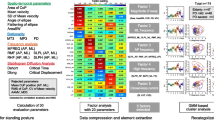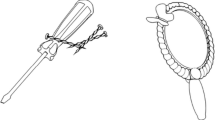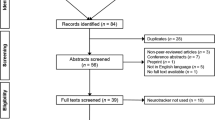Abstract
Despite the accumulating evidence supporting an interaction between cognitive functions and postural control, little is known about the selective impact of the mental representation of an action, i.e., motor imagery (MI) on postural control. As postural oscillations are reduced during a cognitive task of backward silent counting, a greater stability is also expected during MI compared to a no-task condition (standing). Twenty participants took part in this experiment, which aimed at providing evidence that MI may improve postural stability. They were requested to mentally imagine a movement while standing on a force-plate. Results showed a decrease in both path length and postural sway variability on the anterior-posterior and lateral axes during all dual-task sessions, as compared to the motionless condition. These postural adjustments might result from both central and peripheral processes, and/or increased muscle stiffness. Conversely, postural oscillation amplitude increased on the vertical axis during MI of three vertical jumps, hence suggesting that postural regulations remain task-related during MI. Finally, our data showed that kinesthetic and visual imagery differentially impacted the postural regulation.


Similar content being viewed by others
References
Andersson, G., Hagman, J., Talianzadeh, R., Svedberg, A., & Larsen, H. C. (2002). Effect of cognitive load on postural control. Brain Research Bulletin, 58, 135–139.
Andersson, G., Yardley, L., & Luxon, L. (1998). A dual-task study of interference between mental activity and control of balance. American Journal of Otolaryngology, 19, 632–637.
Bakker, F. C., Boschker, M. S., & Chung, T. (1996). Changes in muscular activity while imaging weight-lifting using stimulus or response propositions. Journal of Sport and Exercise Psychology, 18, 313–324.
Bakker, M., de Lange, F. P., Helmich, R. C., Shieringa, R., & Bleom, B. R. (2008a). Cerebral correlates of motor imagery of normal and precision gait. NeuroImage, 41, 998–1010.
Bakker, M., Overeem, S., Snijders, A. H., Borm, G., van Elswijk, G., Toni, I., et al. (2008b). Motor imagery of foot dorsiflexion and gait: Effects on corticospinal excitability. Clinical Neurophysiology, 119, 2519–2527.
Bakker, M., Verstappen, C. C., Bloem, B. R., & Toni, I. (2007). Recent advances in functional neuroimaging of gait. Journal of Neural Transmission, 114, 1323–1331.
Balasubraniam, R., & Wing, A. M. (2002). The dynamics of standing balance. Trends in Cognitive Sciences, 6, 531–536.
Bouisset, S., & Duchene, J. L. (1994). Is body balance more perturbed by respiration in seating than in standing posture? Neuroreport, 5, 957–960.
Brooks, V. B. (1986). The neural basis of motor control. Oxford: Oxford University Press.
Collet, C., & Guillot, A. (2009). Peripheral responses elicited by motor imagery: A window on central and peripheral nervous system relationships related to motor inhibition. In: S. P. Weingarten & H. O. Penat (Eds.), Cognitive psychology research developments (pp. 245–259). Nova Publishers.
Collet, C., & Guillot, A. (2010). Autonomic nervous system activities during imagined movements. In: A. Guillot & C. Collet (Eds.), The neurophysiological foundations of mental and motor imagery (Chap. 7, pp. 95–108). Oxford University Press.
Dault, M. C., Frank, J. S., & Allard, F. (2001). Influence of a visuo-spatial, verbal and central executive working memory task on postural control. Gait and Posture, 14, 110–116.
Dault, M. C., Yardley, L., & Frank, J. S. (2003). Does articulation contribute to modifications of postural control during dual-task paradigms? Cognitive Brain Research, 16, 434–440.
Decety, J. (1996). Do imagined and executed actions share the same neural substrate? Cognitive Brain Research, 3, 87–93.
Decety, J., Perani, D., Jeannerod, M., Bettinardi, V., Tadary, B., Woods, R. P., et al. (1994). Mapping motor representations with positron emission tomography. Nature, 371, 600–602.
Dickstein, R., Dunsky, A., & Marcovitz, E. (2004). Motor imagery for gait rehabilitation in post-stroke hemiparesis. Physical Therapy, 84, 1167–1177.
Donker, S. F., Roerdink, M., Greven, A. J., & Beek, P. J. (2007). Regularity of center-of-pressure trajectories depends on the amount of attention invested in postural control. Experimental Brain Research, 181, 1–11.
Dunsky, A., Dickstein, R., Ariav, C., Deustch, J., & Marcovitz, E. (2006). Motor imagery practice in gait rehabilitation of chronic post-stroke hemiparesis: Four case-studies. International Journal of Rehabilitation Research, 29, 351–356.
Dunsky, A., Dickstein, R., Marcovitz, E., Levy, S., & Deutsch, J. E. (2008). Home-based motor imagery training for gait rehabilitation of people with chronic poststroke hemiparesis. Archives of Physical Medicine and Rehabilitation, 89, 1580–1588.
Ehrenfield, T., Guerraz, M., Thilo, K. V., Yardley, L., & Gresty, M. A. (2003). Posture and mental task performance when viewing a moving visual field. Cognitive Brain Research, 17, 140–153.
Gallese, V. (2005). “Being like me”: Self–other identity, mirror neurons and empathy. In S. Hurley & N. Chater (Eds.), Perspectives on imitation: From cognitive neuroscience to social science (Vol. 1, pp. 101–118). Cambridge, MA: MIT Press.
Gallese, V., & Goldman, A. (1998). Mirror neurons and the simulation theory of mind-reading. Trends Cognitive Sciences, 2, 493–501.
Grush, R. (2004). The emulation theory of representation. Behavioral and Brain Sciences, 27, 347–442.
Guillot, A., & Collet, C. (2005). Duration of mentally simulated movement: A review. Journal of Motor Behavior, 37, 76–84.
Guillot, A., Collet, C., Nguyen, V. A., Malouin, F., Richards, C., & Doyon, J. (2009). Brain activity during visual vs. kinesthetic imagery: An fMRI study. Human Brain Mapping, 30, 2157–2172.
Guillot, A., Lebon, F., Rouffet, D., Champely, S., Doyon, J., & Collet, C. (2007). Muscular responses during motor imagery as a function of muscle contraction types. International Journal of Psychophysiology, 66, 18–27.
Hamel, M. F., & Lajoie, Y. (2005). Mental imagery. Effects on static balance and attentional demands of the elderly. Aging Clinical and Experimental Research, 17, 223–228.
Harris, K. S., & Robinson, W. J. (1986). The effect of skill level on EMG activity during internal and external imagery. Journal of Sport Psychology, 8, 105–111.
Hasan, S. S., Deborah, W. R., Dennis, C. S., Ashmead, D. H., Steven, W. P., & Richard, G. S. (1996). Simultaneous measurement of body center of pressure and center of gravity during upright stance. Gait and Posture, 4, 11–20.
Hunter, M. C., & Hoffman, M. A. (2001). Postural control: Visual and cognitive manipulations. Gait and Posture, 13, 41–48.
Jeannerod, M. (1994). The representing brain: Neural correlates of motor intention and imagery. Behavioral Brain Science, 17, 187–245.
Kosslyn, S. M., Ganis, G., & Thompson, W. L. (2010). Multimodal images in the brain. In: Guillot A., & Collet C. (Eds), The neurophysiological foundations of mental and motor imagery (pp. 3–16). Oxford University Press.
Kuo, A. D. (2005). An optimal state estimation models of sensory integration in human postural balance. Journal of Neural Engineering, 2, 235–249.
Lajoie, Y., Teasdale, N., Bard, C., & Fleury, M. (1993). Attentional demand for static and dynamic equilibrium. Experimental Brain Research, 97, 139–144.
Le Clair, K., & Riach, C. (1996). Postural stability measures: What to measure and how long? Clinical Biomechanics, 11, 176–178.
Le Pellec, A., & Maton, B. (2000). Anticipatory postural adjustments depend on final equilibrium and task complexity in vertical high jump movements. Journal of Electromyography and Kinesiology, 10, 171–178.
Le Pellec, A., & Maton, B. (2002). Initiation of a vertical jump: The human body’s upward propulsion depends on control of forward equilibrium. Neuroscience Letters, 323, 183–186.
Lebon, F., Guillot, A., Rouffet, D., & Collet, C. (2008). EMG correlates different types of muscular contraction during motor imagery. Neuroscience Letters, 435, 181–185.
Lorey, B., Bischoff, M., Pilgramm, S., Stark, R., Munzert, J., & Zentgraf, K. (2009). The embodied nature of motor imagery: The influence of posture and perspective. Experimental Brain Research, 194, 233–243.
Marsh, A. P., & Geel, S. E. (2000). The effect of age on the attentional demands of postural control. Gait and Posture, 12, 105–113.
Maylor, E. A., Allison, S., & Wing, A. M. (2001). Effects of spatial and non-spatial cognitive activity on postural stability. British Journal of Psychology, 92, 319–338.
McNevin, N. H., & Wulf, G. (2002). Attentional focus on supra-postural tasks affects postural control. Human Movement Science, 21, 187–202.
Morasso, P. G., Baratto, L., Capra, R., & Spada, G. (1999). Internal models in the control of posture. Neural Networks, 12, 1173–1180.
Newell, K. M., van Emmerik, R. E. A., Lee, D., & Sprague, R. L. (1993). On postural stability and variability. Gait and Posture, 1, 225–230.
Norrie, R. G., Maki, B. E., Staines, W. R., & Mc Ilroy, W. E. (2002). The time course of attention shifts following perturbation of upright stance. Experimental Brain Research, 146, 315–321.
Pellecchia, G. L. (2003). Postural sway increases with attentional demands of concurrent cognitive tasks. Gait and Posture, 18, 29–34.
Redfern, M. S., Jennings, J. R., Martin, C., & Furman, J. M. (2001). Attention influences sensory integration for postural control in older adults. Gait and Posture, 14, 211–216.
Riley, M. A., Baker, A. A., & Schimt, J. M. (2003). Inverse relation between postural variability and difficulty of a concurrent short-term memory task. Brain Research Bulletin, 62, 191–195.
Rodrigues, E. C., Imbiriba, L. A., Leite, G. R., Magahlaes, J., Volchan, E., & Vargas, C. D. (2003). Mental simulation strategy affects postural control. Review Brasileiro de Psiquiatria, 25, 33–35.
Rodrigues, E. C., Lemos, T., Gouvea, E., Volchan, L. A., Imbiriba, L. A., & Vargas, C. D. (2010). Kinesthetic motor imagery modulates body sway. Neuroscience, 169, 743–750.
Ruby, P., & Decety, J. (2001). Effect of subjective perspective taking during simulation of action: A PET investigation of agency. Nature Neuroscience, 4, 546–550.
Shumway-Cook, A., Woollacott, M., Kerns, K. A., & Baldwin, M. (1997). The effects of two types of cognitive tasks on postural stability in older adults with and without a history of falls. Journal of Gerontology: Medical Sciences, 52, 232–240.
Simoneau, M., Teasdale, N., Bourdin, C., Bard, C., Fleury, M., & Nougier, V. (1999). Aging and postural control: Postural perturbations caused by changing the visual anchor. Journal of American Geriatrics Society, 47, 235–240.
Sirigu, A., & Duhamel, J. R. (2001). Motor and visual imagery as two complementary but neutrally dissociable mental processes. Journal of Cognitive Neuroscience, 13, 910–919.
Solodkin, A., Hlustik, P., Chen, E. E., & Small, S. L. (2004). Fine modulation in network activation during motor execution and motor imagery. Cerebral Cortex, 14, 1246–1255.
Stinear, C. M., Byblow, W. D., Steyvers, M., Levin, O., & Swinnen, S. P. (2006). Kinesthetic, but not visual, motor imagery modulates corticomotor excitability. Experimental Brain Research, 168, 157–164.
Stoffregen, T. A., Smart, L. J., Bardy, B. G., & Pagulayan, R. J. (1999). Postural stabilization of looking. Journal of Experimental Psychology, 25, 1641–1658.
Teasdale, N., Bard, C., Larue, J., & Fleury, M. (1993). On the cognitive penetrability of postural control. Experimental Aging Research, 19, 1–13.
Teasdale, N., & Simoneau, M. (2001). Attentional demands for postural control: The effects of aging and sensory reintegration. Gait and Posture, 14, 203–210.
Vuillerme, N., Nougier, V., & Teasdale, N. (2000). Effects of a reaction time task on postural control in humans. Neuroscience Letters, 291, 77–80.
Wang, Y., & Morgan, W. P. (1992). The effect of imagery perspectives on the psychophysiological responses to imagined exercise. Behavioural Brain Research, 52, 167–174.
Winter, D. A., Patla, A. E., Prince, F., Ishac, M., & Gielo-Perczak, K. (1998). Stiffness control of balance in quiet standing. Journal of Neurophysiology, 80, 1211–1221.
Wolpert, D. M., & Ghahramani, Z. (2000). Computational principles of movement neuroscience. Nature Neuroscience, 3, 1212–1217.
Woollacott, M., & Shumway-Cook, A. (2002). Attention and the control of posture and gait: A review of an emerging area of research. Gait and Posture, 16, 1–14.
Wulf, G., McNevin, N. H., & Shea, C. H. (2001). The automaticity of complex motor skill learning as a function of attentional focus. The Quarterly Journal of Experimental Psychology, 54A, 1143–1154.
Yardley, L., Gardney, M., Bronstein, A., Davies, R., Buckwell, D., & Luxon, L. (2001). Interference between postural control and mental task performance in patients with vestibular disorders and healthy controls. Journal of Neurology, Neurosurgery and Psychiatry, 71, 48–52.
Yardley, L., Gardney, M., Leadbetter, A., & Lavie, N. (1999). Effect of articulatory and mental tasks on postural control. Neuroreport, 10, 215–219.
Author information
Authors and Affiliations
Corresponding author
Rights and permissions
About this article
Cite this article
Grangeon, M., Guillot, A. & Collet, C. Postural Control During Visual and Kinesthetic Motor Imagery. Appl Psychophysiol Biofeedback 36, 47–56 (2011). https://doi.org/10.1007/s10484-011-9145-2
Published:
Issue Date:
DOI: https://doi.org/10.1007/s10484-011-9145-2




